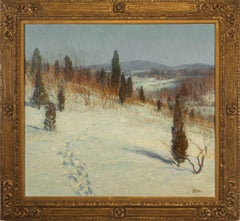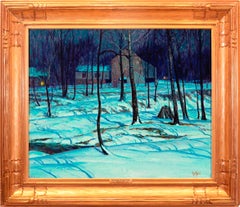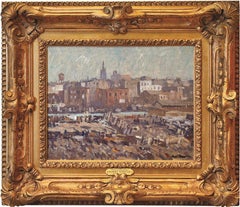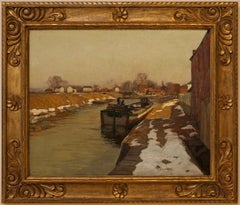Jim's of Lambertville Art
to
74
103
101
75
71
Overall Width
to
Overall Height
to
7
392
25
9
18
30
48
37
22
27
20
3
2
193
100
71
2
270
134
10
108
48
47
34
27
25
24
20
18
14
12
10
10
7
7
6
6
6
5
4
339
303
213
206
78
63
51
18
16
13
403
424
"Cedar Hill"
By George William Sotter
Located in Lambertville, NJ
Jim’s of Lambertville is proud to offer this artwork.
Signed lower right.
Original Period Newcomb Macklin Frame
George William Sotter (1879 - 1953)
Born in Pittsburgh on September 25, 1879, Sotter began his art education with local teachers and with Henry G. Keller, who had studied in various German academies. Keller, known for his superb, atmospheric watercolors, taught at the Cleveland School of Art but Sotter studied with him in Pittsburgh. Later Sotter would exhibit between 1903 and 1937 at the Pennsylvania Academy of the Fine Arts. His works were also shown at the Corcoran Gallery (1912-23), the Carnegie International (1901-26), the National Academy of Design (1913 and 1921), and at the Art Institute of Chicago (1911-27). In 1915, Sotter exhibited four works at the Panama-Pacific International Exposition in San Francisco, where he won a silver medal. Sotter was known mainly as a stained-glass artist; his work may be seen from New York City to Salt Lake City. Around a dozen craftsmen worked under him for these commissions.
Sotter spent the summer of 1902 with Pennsylvania impressionist Edward Redfield in Boothbay Harbor, Maine. Between 1910 and 1919, Sotter taught at the Carnegie Institute of Technology. His paintings often feature large areas of sky filled with clouds and he frequently painted winter night scenes, such as Moonlight, Bucks County (Beacon Hill Fine Art), a perfectly successful depiction of a quiet, moonlit landscape filled with twinkling stars. Star-studded skies, although rare in landscape painting, go back at least to 1600 when they appear in the oeuvre of Adam Elsheimer...
Category
20th Century Abstract Impressionist Paintings
Materials
Canvas, Oil
"The Neighbors"
By George William Sotter
Located in Lambertville, NJ
Jim’s of Lambertville is proud to offer this artwork.
Signed lower right and is Illustrated in the Ashley John Gallery catalog titled "The Pennsylvania Impressionists".
George William Sotter (1879 - 1953)
Born in Pittsburgh on September 25, 1879, Sotter began his art education with local teachers and with Henry G. Keller, who had studied in various German academies. Keller, known for his superb, atmospheric watercolors, taught at the Cleveland School of Art but Sotter studied with him in Pittsburgh. Later Sotter would exhibit between 1903 and 1937 at the Pennsylvania Academy of the Fine Arts. His works were also shown at the Corcoran Gallery (1912-23), the Carnegie International (1901-26), the National Academy of Design (1913 and 1921), and at the Art Institute of Chicago (1911-27). In 1915, Sotter exhibited four works at the Panama-Pacific International Exposition in San Francisco, where he won a silver medal. Sotter was known mainly as a stained-glass artist; his work may be seen from New York City to Salt Lake City. Around a dozen craftsmen worked under him for these commissions.
Sotter spent the summer of 1902 with Pennsylvania impressionist Edward Redfield in Boothbay Harbor, Maine. Between 1910 and 1919, Sotter taught at the Carnegie Institute of Technology. His paintings often feature large areas of sky filled with clouds and he frequently painted winter night scenes, such as Moonlight, Bucks County (Beacon Hill Fine Art), a perfectly successful depiction of a quiet, moonlit landscape filled with twinkling stars. Star-studded skies, although rare in landscape painting, go back at least to 1600 when they appear in the oeuvre of Adam Elsheimer...
Category
20th Century American Impressionist Paintings
Materials
Canvas, Oil
"Note of the City"
By Robert Spencer
Located in Lambertville, NJ
Jim’s of Lambertville is proud to offer this artwork.
Signed lower right
Period frame
Robert Spencer (1879 - 1931)
One of the rarest and most important artists among the New Hope...
Category
20th Century American Impressionist Paintings
Materials
Canvas, Oil
"The Canal"
By Edward Willis Redfield
Located in Lambertville, NJ
Jim’s of Lambertville is proud to offer this artwork.
Signed lower left. Complemented by a hand carved and gilt frame.
Illustrated in "Edward Redfield: Just Values and Fine Seeing" by Constance Kimmerle and the Pennsylvania Academy of the Fine Arts's Exhibition of Paintings by Edward Redfield (April 17 to May 16, 1909) brochure
Edward Willis Redfield (1869 - 1965)
Edward W. Redfield was born in Bridgeville, Delaware, moving to Philadelphia as a young child. Determined to be an artist from an early age, he studied at the Spring Garden Institute and the Franklin Institute before entering the Pennsylvania Academy from 1887 to 1889, where he studied under Thomas Anshutz, James Kelly, and Thomas Hovenden. Along with his friend and fellow artist, Robert Henri, he traveled abroad in 1889 and studied at the Academie Julian in Paris under William Bouguereau and Tony Robert-Fleury. While in France, Redfield met Elise Deligant, the daughter of an innkeeper, and married in London in 1893.
Upon his return to the United States, Redfield and his wife settled in Glenside, Pennsylvania. He remained there until 1898, at which time he moved his family to Center Bridge, a town several miles north of New Hope along the Delaware River. Redfield painted prolifically in the 1890s but it was not until the beginning of the twentieth century that he would develop the bold impressionist style that defined his career. As Redfield’s international reputation spread, many young artists gravitated to New Hope as he was a great inspiration and an iconic role model. Edward Redfield remained in Center Bridge throughout his long life, fathering his six children there.
Around 1905 and 1906, Redfield’s style was coming into its own, employing thick vigorous brush strokes tightly woven and layered with a multitude of colors. These large plein-air canvases define the essence of Pennsylvania Impressionism. By 1907, Redfield had perfected his craft and, from this point forward, was creating some of his finest work.
Redfield would once again return to France where he painted a small but important body of work between 1907 and 1908. While there, he received an Honorable Mention from the Paris Salon for one of these canvases. In 1910 he was awarded a Gold Medal at the prestigious Buenos Aires Exposition and at the Panama-Pacific Exposition of 1915 in San Francisco, an entire gallery was dedicated for twenty-one of his paintings.
Since Redfield painted for Exhibition with the intent to win medals, his best effort often went into his larger paintings. Although he also painted many fine smaller pictures, virtually all of his works were of major award-winning canvas sizes of 38x50 or 50x56 inches. If one were to assign a period of Redfield’s work that was representative of his “best period”, it would have to be from 1907 to 1925. Although he was capable of creating masterpieces though the late 1940s, his style fully matured by 1907 and most work from then through the early twenties was of consistently high quality. In the later 1920s and through the 1930s and 1940s, he was like most other great artists, creating some paintings that were superb examples and others that were of more ordinary quality.
Redfield earned an international reputation at a young age, known for accurately recording nature with his canvases and painting virtually all of his work outdoors; Redfield was one of a rare breed. He was regarded as the pioneer of impressionist winter landscape painting in America, having few if any equals. Redfield spent summers in Maine, first at Boothbay Harbor and beginning in the 1920s, on Monhegan Island. There he painted colorful marine and coastal scenes as well as the island’s landscape and fishing shacks. He remained active painting and making Windsor style furniture...
Category
Early 1900s American Impressionist Landscape Paintings
Materials
Canvas, Oil



